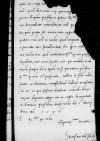List #2918
Stanisław WŁOSZEK do Ioannes DANTISCUSVilnius, 1546-03-01
| odebrano Heilsberg (Lidzbark Warmiński), 1546-03-10 Rękopiśmienne podstawy źródłowe:
| ||||
Tekst + aparat krytyczny + komentarzZwykły tekstTekst + komentarzTekst + aparat krytyczny
Reverendissimo in Christo Patri et Domino, domino
Reverendissime in Christo Pater et Domine, domine gratiotissime.
Ut Reverendissima Paternitas Vestra diu felix et incolumis valeat pro commodo rei publicae et consolatione gregis sui, a Domino Deo precor.
Litteras Reverendissimae Paternitatis Vestrae et magnifici domini  BCz, 1599, p. 666de satisfactum est consilio et desiderio Reverendissimae Paternitatis Vestrae trac hidden by binding⌈[trac]trac hidden by binding⌉tavit enim
BCz, 1599, p. 666de satisfactum est consilio et desiderio Reverendissimae Paternitatis Vestrae trac hidden by binding⌈[trac]trac hidden by binding⌉tavit enim
Ubi vero Reverendissima Paternitas Vestra commendatione praedicti magnifici hidden by binding⌈[gnifici]gnifici hidden by binding⌉ domini  BCz, 1599, p. 667 optimi viri erga me [...] paper damaged⌈[...][...] paper damaged⌉ [...] paper damaged⌈[...][...] paper damaged⌉tudo, quod, dum vivo, vix quocumque [...] paper damaged⌈[...][...] paper damaged⌉ parem illi gratiam persolvere potero, Reverendissimae P[...] paper damaged⌈[...][...] paper damaged⌉ eius benevolenti commendatione mihi par[...] paper damaged⌈[...][...] paper damaged⌉tas [...] paper damaged⌈[...][...] paper damaged⌉, quam grata sit animo meo exprim[...] paper damaged⌈[...][...] paper damaged⌉ [...] paper damaged⌈[...][...] paper damaged⌉ gratior etiam vel eo nomine, quod originem [...] paper damaged⌈[...][...] paper damaged⌉ a parentis mei familiaritate, hoc spem mihi [...] paper damaged⌈[...][...] paper damaged⌉ non mediocrem, quod constantem Reverendissima Paternitas Vestra praese or praefe⌈praesepraese or praefe⌉[...] paper damaged⌈[...][...] paper damaged⌉ dignabitur, meae etiam partis erit, pro modulo virium mearum semper dare operam, ut si parentem gratia sua Reverendissima Paternitas Vestra est prosecuta, iustam et filium eodem favore et clementia complectendi habeat occasionem.
BCz, 1599, p. 667 optimi viri erga me [...] paper damaged⌈[...][...] paper damaged⌉ [...] paper damaged⌈[...][...] paper damaged⌉tudo, quod, dum vivo, vix quocumque [...] paper damaged⌈[...][...] paper damaged⌉ parem illi gratiam persolvere potero, Reverendissimae P[...] paper damaged⌈[...][...] paper damaged⌉ eius benevolenti commendatione mihi par[...] paper damaged⌈[...][...] paper damaged⌉tas [...] paper damaged⌈[...][...] paper damaged⌉, quam grata sit animo meo exprim[...] paper damaged⌈[...][...] paper damaged⌉ [...] paper damaged⌈[...][...] paper damaged⌉ gratior etiam vel eo nomine, quod originem [...] paper damaged⌈[...][...] paper damaged⌉ a parentis mei familiaritate, hoc spem mihi [...] paper damaged⌈[...][...] paper damaged⌉ non mediocrem, quod constantem Reverendissima Paternitas Vestra praese or praefe⌈praesepraese or praefe⌉[...] paper damaged⌈[...][...] paper damaged⌉ dignabitur, meae etiam partis erit, pro modulo virium mearum semper dare operam, ut si parentem gratia sua Reverendissima Paternitas Vestra est prosecuta, iustam et filium eodem favore et clementia complectendi habeat occasionem.
Cui me ea, qua possum, devotione commendo obnixe rogans, dignetur e ms. in(!) ⌈ee ms. in(!) ⌉rga me in coepta benignitate et clementia persistere.
Dat(ae) or Dat(um)⌈Dat(ae)Dat(ae) or Dat(um)⌉
Eiusdem Reverendissimae Paternitatis Vestrae obsequentissimus servitor
[1] Above “m” redundant sign of abbreviation.



